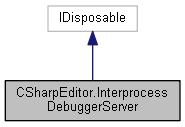|
CSharpEditor
1.1.2
A C# source code editor with syntax highlighting, intelligent code completion and real-time compilation error checking
|
|
CSharpEditor
1.1.2
A C# source code editor with syntax highlighting, intelligent code completion and real-time compilation error checking
|
A class used to analyse breakpoints on a separate process (to avoid deadlocks with breakpoints in synchronous code). More...

Public Member Functions | |
| InterprocessDebuggerServer (string clientExePath) | |
| Initializes a new InterprocessDebuggerServer, starting the client process and establishing pipes to communicate with it. More... | |
| InterprocessDebuggerServer (string clientExePath, IEnumerable< string > initialArguments) | |
| Initializes a new InterprocessDebuggerServer, starting the client process and establishing pipes to communicate with it. More... | |
| InterprocessDebuggerServer (string clientExePath, IEnumerable< string > initialArguments, Func< int, int > getClientPid) | |
| Initializes a new InterprocessDebuggerServer, starting the client process and establishing pipes to communicate with it. More... | |
| Func< BreakpointInfo, bool > | SynchronousBreak (Editor editor) |
| Returns a function to handle breakpoints in synchronous methods by transferring the breakpoint information to the client process. Pass the output of this method as an argument to Editor.Compile(Func<BreakpointInfo, bool>, Func<BreakpointInfo, Task<bool>>). The function will lock until the client process signals that execution can resume. More... | |
| Func< BreakpointInfo, Task< bool > > | AsynchronousBreak (Editor editor) |
| Returns a function to handle breakpoints in asynchronous methods by transferring the breakpoint information to the client process. Pass the output of this method as an argument to Editor.Compile(Func<BreakpointInfo, bool>, Func<BreakpointInfo, Task<bool>>). This function will actually execute synchronously and lock until the client process signals that execution can resume. More... | |
| void | Dispose () |
| Kills the debugger client process and frees the pipe resources. More... | |
A class used to analyse breakpoints on a separate process (to avoid deadlocks with breakpoints in synchronous code).
Definition at line 39 of file InterprocessDebugger.cs.
| CSharpEditor.InterprocessDebuggerServer.InterprocessDebuggerServer | ( | string | clientExePath | ) |
Initializes a new InterprocessDebuggerServer, starting the client process and establishing pipes to communicate with it.
| clientExePath | The path to the executable of the client process. |
Definition at line 55 of file InterprocessDebugger.cs.
| CSharpEditor.InterprocessDebuggerServer.InterprocessDebuggerServer | ( | string | clientExePath, |
| IEnumerable< string > | initialArguments | ||
| ) |
Initializes a new InterprocessDebuggerServer, starting the client process and establishing pipes to communicate with it.
| clientExePath | The path to the executable of the client process. |
| initialArguments | The arguments that will be used to start the client process. The additional arguments specific to the InterprocessDebuggerServer will be appended after these. |
Definition at line 65 of file InterprocessDebugger.cs.
| CSharpEditor.InterprocessDebuggerServer.InterprocessDebuggerServer | ( | string | clientExePath, |
| IEnumerable< string > | initialArguments, | ||
| Func< int, int > | getClientPid | ||
| ) |
Initializes a new InterprocessDebuggerServer, starting the client process and establishing pipes to communicate with it.
| clientExePath | The path to the executable of the client process. |
| initialArguments | The arguments that will be used to start the client process. The additional arguments specific to the InterprocessDebuggerServer will be appended after these. |
| getClientPid | A method that returns the process identifier (PID) of the client debugger process. The argument of this method is the PID of the process that has been started by the server. If this is null, it is assumed that the process started by the server is the client debugger process. |
Definition at line 76 of file InterprocessDebugger.cs.
| Func<BreakpointInfo, Task<bool> > CSharpEditor.InterprocessDebuggerServer.AsynchronousBreak | ( | Editor | editor | ) |
Returns a function to handle breakpoints in asynchronous methods by transferring the breakpoint information to the client process. Pass the output of this method as an argument to Editor.Compile(Func<BreakpointInfo, bool>, Func<BreakpointInfo, Task<bool>>). This function will actually execute synchronously and lock until the client process signals that execution can resume.
| editor | The Editor whose code will be debugged. Note that no reference to this object is kept after this method returns. |
Definition at line 267 of file InterprocessDebugger.cs.
| void CSharpEditor.InterprocessDebuggerServer.Dispose | ( | ) |
Kills the debugger client process and frees the pipe resources.
Definition at line 442 of file InterprocessDebugger.cs.
| Func<BreakpointInfo, bool> CSharpEditor.InterprocessDebuggerServer.SynchronousBreak | ( | Editor | editor | ) |
Returns a function to handle breakpoints in synchronous methods by transferring the breakpoint information to the client process. Pass the output of this method as an argument to Editor.Compile(Func<BreakpointInfo, bool>, Func<BreakpointInfo, Task<bool>>). The function will lock until the client process signals that execution can resume.
| editor | The Editor whose code will be debugged. Note that no reference to this object is kept after this method returns. |
Definition at line 143 of file InterprocessDebugger.cs.